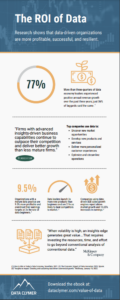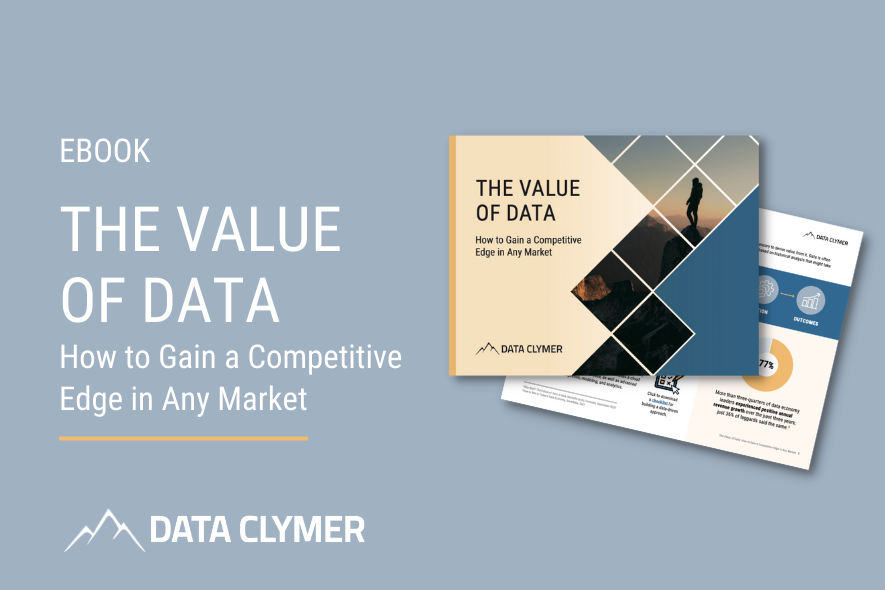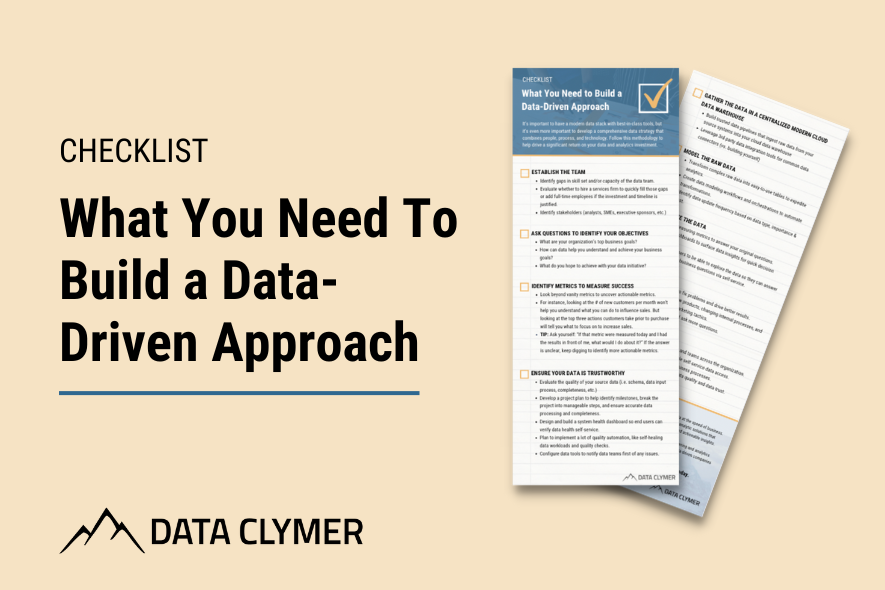Economic shifts over the last several years have profoundly impacted businesses. Between the pandemic, supply chain disruptions, inflation, rising interest rates, and global conflict, many management teams say it’s the most challenging environment they’ve ever faced. Leaders are convinced of the business value of data, but most don’t know how to unlock it. And yet, the reasons to do so are compelling.
When evaluating the business value of data, consider:
- Data grows revenue. More than three-quarters of data economy leaders experienced positive annual revenue growth over the past three years; just 36% of laggards said the same. (Snowflake)
- Data drives product innovation. Data leaders launch 3x more new products than beginners and are 2.9x as likely to beat competitors to market (Splunk)
- Data fuels sales. Companies using data-driven B2B sales-growth engines report above market growth and 15-25% increases in earnings (McKinsey & Company)
Strategies to Unlock the Value of Data
Start envisioning what’s possible by looking at your business and thinking holistically about the opportunities in your data ecosystem. What business outcomes are you trying to drive? What data would support those outcomes?
Use the following ideas to jump-start your imagination.
Related Ebook: The Value of Data: How to Gain a Competitive Edge in Any Market
1. Build a customer churn early warning system.
Customer retention is often at the top of the priority list in a downward economic cycle. Instead of being reactive, organizations can be proactive by creating a customer churn early warning system. Leverage product usage data, licensing information, and other customer data to check the health of the customer—then take any necessary action to keep them.
One organization Data Clymer worked with analyzed usage and revenue data to understand how customers retained over various time frames affected revenue. The company honed in on the 7-day mark as the most critical place to increase retention. The email marketing team then devised a 7-day customer journey with optimal customer communication touch points. Meanwhile, the customer support team worked on improving support ticket response times.
Because of the focused strategy and KPI, the business was able to drive a 50% increase in 7-day retention.
2. Develop a dynamic pricing strategy to address inflation risks.
McKinsey & Company shared insights on how company leaders can use analytics-aided strategies to help protect their business in an inflationary environment.
For example, a manufacturing company analyzed customer patterns to roll out granular price increases across thousands of products. They received minimal customer complaints. Compare this to a packaging company that experienced double-digit market share losses after failing to prepare its sales force for sudden, drastic price changes.
A dynamic pricing strategy can drive significant benefits over the short- and long-term. It can be especially powerful for product-driven companies in industries like ecommerce/retail, food and beverage, manufacturing, and sports teams and entertainment venues.
3. Segment customers and prospects to personalize sales and marketing.
Segmenting your customers and prospects will allow you to better understand how various verticals and personas interact with your marketing campaigns and communications. You can then personalize your marketing strategies and create content and tactics that will better resonate with each segment’s needs and wants. Even better, combine that knowledge with artificial intelligence and machine learning to prescribe and expedite follow-up actions.
At a higher level, marketing leaders can better align their overall go-to-market and marketing strategy with the segments that are performing best. Develop new strategies to manage underperforming segments or use data to make a case for why they shouldn’t be a focus.
Related: How to Activate Your Customer Data for Marketing
4. Reduce risk with proactive corrective actions.
Poor credit-risk management can lead to late payments and bad debt. Instead of waiting for issues to arise, use rich data to identify high-risk customers upfront and develop proactive solutions.
For example, one energy retailer took a data-driven approach to reduce future financial risks. They used defined KPIs throughout the customer journey to flag individuals and businesses that were likely to default or make late payments. Next, they segmented and targeted these customers with corrective actions like cash-back bonuses and installment-payment schemes. They effectively lowered the risk of late and missed payments, using data to pave the way.
5: Track progress toward company goals with a near real-time dashboard.
As the old adage goes, “If you can’t measure it, you can’t improve it.” Today’s businesses tie more and more decisions and outcomes to data. Integrate multiple data sources into a single source of truth and create a dashboard to view progress toward company goals.
By making timely metrics highly visible, functional areas across the company can more effectively contribute to business goals. Teams can better collaborate on plans to improve performance. Leaders can view up-to-the-minute progress so they can make decisions and act accordingly. The same concept can be applied for any type of near real-time dashboard: ARR, marketing conversions, sales forecasts, or team capacity.
Related: How a Top Coffee Chain Uses a One-Stop Supply Chain Planning Dashboard
Transforming Your Business
Becoming a data-driven organization is not easy, but the benefits are endless. Any business problem you have, data can help you solve it. Download our ebook “The Value of Data” for more ideas on how to use data to build deep customer knowledge, drive timely decision making, and improve operational efficiency.




